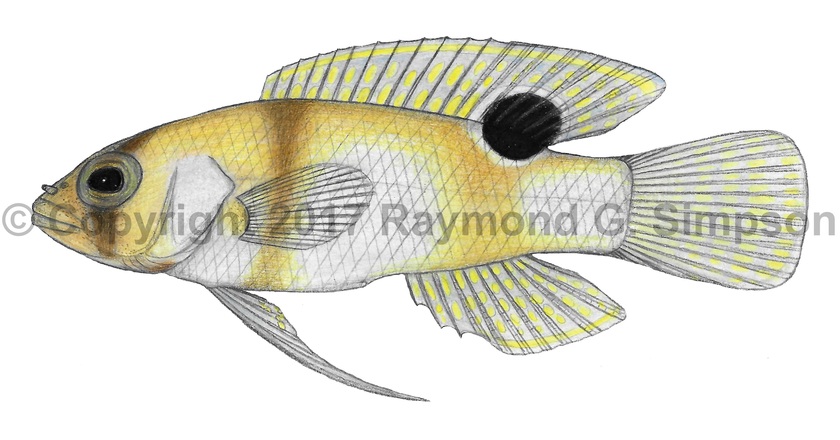
Common Name
Yellow-banded Basslet
Year Described
Baldwin, Nonaka, & Robertson, 2016
Identification
Dorsal Fin: XII, 9
Anal Fin: III, 8
Pelvic Fin: I, 5
Pectoral Fin: 15-16 (usually 16)
Caudal Rays: 17 (principal)
Gill Rakers: 15-16 (usually 16)
Vertebrae: 10 precaudal, 15 caudal; 25 total
Lateral Scale Rows: ~24
Body stout with blunt snout. Four supraorbital pores; two pores on rear margin of orbit. Lateral line absent. Preopercular margin smooth. Pelvic fin extends well past anal fin origin when depressed. Outer procurrent caudal rays thickened (3 ventrally and dorsally). Caudal fin with rounded lobes.
Color
Body whitish with a golden yellowish cast dorsally and on the head. Brown eye and middle body band obvious and about width of orbit. Middle band reaches belly. Rear brown band faint or incomplete, and usually reduced to a yellow band matching body coloration. A prominent ocellus on the rear dorsal fin surrounded by white. Dorsal fin gray to blue with 2-3 rows of yellow spots and a submarginal yellow stripe. Anal fin gray to blue with several rows of small yellow spots. Caudal fin gray to blue with many small yellow spots on fin membranes. Pelvic fins whitish with a few tiny golden spots. Pectoral fin clear.
Size
Maximum size to 40mm SL.
Habitat
Taken on deep reefs between 150-250m.
Range
So far collected only off Klein Curacao, but not off the main island itself.
References
Baldwin, C.C., D.R. Robertson, A. Nonaka & L. Tornabene. 2016. Two new deep-reef basslets (Teleostei, Grammatidae, Lipogramma), with comments on the eco-evoluntionary relationships of the genus. ZooKeys No. 638: 45-82.
Other Notes
Most closely related to Lipogramma evides, but differs in several morphological (gill rakers, coloration) and genetic (11% CO1 divergence) differences (Baldwin et al., 2016).